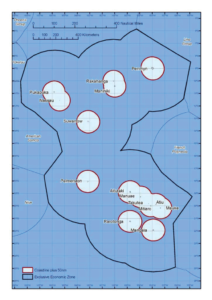Protecting the Cook Islands’ Sacred Ocean
The Cook Islands is a nation of vastly more water than land. An expanse of ocean approximately the size of Mexico surrounds the small, scattered islands, some home to no more than a few dozen residents. Beneath the water’s surface is a rich ecosystem, filled with endangered turtles, 22 kinds of whales, and vibrant coral reefs that support hundreds of fish species and other organisms.
Seacology is honored to play a role in a comprehensive new plan to protect this natural bounty for future generations.

Three years ago, the Cook Islands took the unprecedented step of protecting its ocean resources by establishing Marae Moana, the world’s largest multi-use marine park. Encompassing the country’s entire exclusive economic zone–763,000 square miles–the reserve is unprecedented in its size and ambition.
Meaning “sacred ocean” in the local Māori language, Marae Moana sets new national standards for responsible resource use. It prohibits commercial fishing and seabed mining in the 50-mile radius around each of the country’s major islands, where biodiversity is most concentrated. It addresses long-mounting problems stemming from commercial fishing, both the direct impact on fish populations, and the pollution from discarded nets and other materials.
In January a delegation from the Cook Islands visited the United States and met with Seacology’s leaders and members of our Seacology Fellows community. Our guests included then-Prime Minister Henry Puna, who had steered the legislation through the country’s parliament, ultimately passing it with unanimous support. We also welcomed Kevin Iro, a former rugby star turned environmentalist who was one of the most visible public faces of the idea. This summer, Seacology officially became part of the coalition of NGOs, governments, and ordinary Cook Islanders committed to ensuring the ambitious plan’s success. With a $100,000 grant, we are funding a nationwide education campaign to promote Marae Moana, using traditional and social media, classroom presentations, and other forms of outreach, even to the most remote and isolated islands.
For a geographically huge country of only 17,000 citizens and limited resources, managing a reserve of this scale presents unique challenges. When Marae Moana was established, the country had only one vessel to patrol its waters. The government will expand its enforcement capacity through technology and cooperation with neighboring states, but buy-in from average people is still crucial if the park is to be an environmental success.
Former Cook Islands Prime Minister Henry Puna (left) and Kevin Iro (right) visit the Seacology office.
The waters of the Cook Islands support a vast diversity of marine life. © Marae Moana
“The Cook islands took a bold step forward in protecting the world’s oceans,” said Seacology Executive Director Duane Silverstein. “It is now up to the nation to make this a park that not only works on paper but works in the real world to protect fragile marine ecosystems. This can happen only if the local people are fully informed about the marine park and solidly behind its implementation.”
Fortunately, there is a long and deep tradition of ocean stewardship in the country. The Cook Islands’ marine ecosystem has sustained human societies for a millennium and spawned a unique seafaring culture. After the country regained political autonomy in the 1960s, this traditional respect for the sea began to re-emerge. And when local fisheries declined, these values of stewardship reasserted themselves in the public consciousness. Our project partner, the Cook Islands Voyaging Society, has been at the forefront of promoting these values. They sail in traditional boats, called vaka, to the country’s remote islands, teaching youth about their rich heritage and the importance of the ocean for their way of life and prosperity.
The first public act of our partnership took place in August, when Seacology underwrote the voyage of the vaka Marumaru Atua across Marae Moana. Traveling from the main island of Rarotonga to Mangaia to attend the promotion of a local king, the 250-mile round trip through the Cook Islands’ blue waters was a bold demonstration of Seacology’s mission: protecting the unique habitats and cultures of the world’s islands.
The Vaka Marumaru Atua crosses Marae Moana. © Marae Moana
Members of the Cook Islands Voyaging Society prepare to set sail on the Marumaru Atua. © Marae Moana

